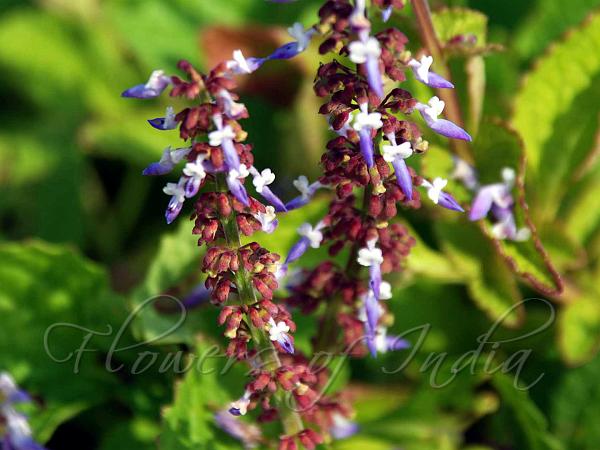|
| Chinese Potato |
|

|

|
|
|
|
Photo: |
Botanical name: Plectranthus rotundifolius Family: Lamiaceae (Mint family)
Synonyms: Coleus rotundifolius, Plectranthus tuberosus, Coleus parviflorus
Synonyms: Coleus rotundifolius, Plectranthus tuberosus, Coleus parviflorus
Chinese Potato is a perennial herb native to India
and tropical Africa. It is cultivated in parts of West Africa, South
Asia and Southeast Asia for its edible tubers. It is a herb with
prostrate or ascending habit and a succulent stem reaching up to 15-30
cm in length, forming tubers in clusters around the base of the stem.
The tubers are small and dark-brown.
The stem is decumbent or ascending, quadrangular, with densely
pubescent on the angles and roots at the nodes. The leaves are rather
thick, juicy, faintly aromatic when bruised and arranged oppositely.
The leaf-stalk is 1-3 cm long and puberulous. The blade is ovate to
nearly round, measuring 2-6 cm x 1.5-4 cm, wedge-shaped at the base,
coarsely toothed at the margins. The inflorescence is a terminal false
spike, measuring 5-15 cm long, with distant whorls of 4-6 flowers. The
flower-stalk is 1-2 mm long. The bracts are small. The sepal is
bell-shaped, measuring 1.5-3 mm long, glandular-hairy and 5-toothed.
The upper tooth is oblong, pointed and very short median teeth with
rounded tip while the lower teeth is highly fused that forms an almost
flat tip but ends abruptly in 2 widely apart acute tips. The flower is
tubular and 2-lipped, measuring 7-12 mm long, light to dark violet,
velvety and gland-dotted. The tube is strongly curved. The upper lip is
very short and with 4-lobed while the lower lip is boat-shaped. There
are 4 stamens that curved within the lower lip. They are up to 2.5 mm
long, shortly unite at the base and envelope the style. The style is
2-fid and slightly exceeding the stamens. Flowering: September-October.
Identification credit: Asokan Mash
| Photographed in Chembuchira,Thrissur distt, Kerala. |